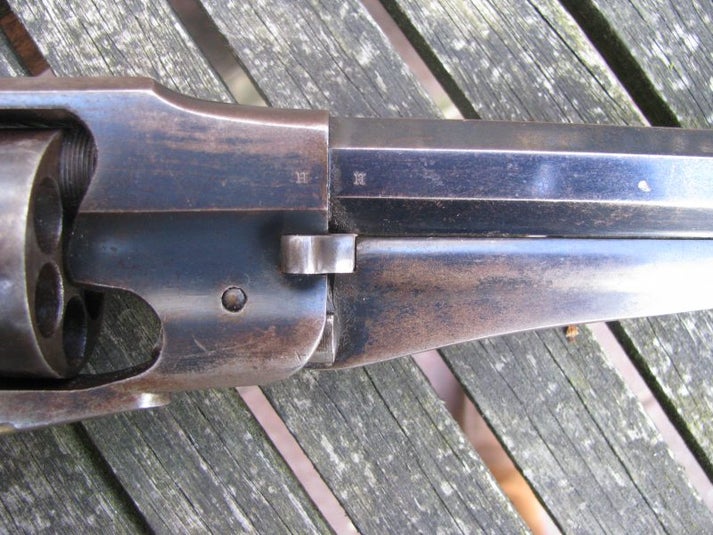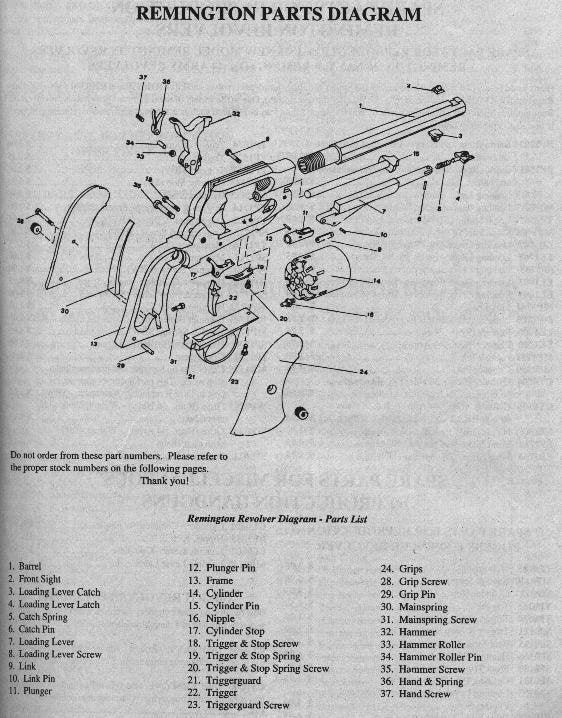Remington 1858 Army
Remington New Model 1858 Army New Jersey Purchase

Picture Remington Army New Jersey Purchase from the OutlawsColts Collection
Procured in 1864 as part of a 1000 piece order placed August 8 of that year by the Quartermaster General of New Jersey, at a unit cost of $12.70. "N.J" is stamped on the left side of the barrel just ahead of the frame, "R" on the outside face of the cylinder and the right side of the barrel and frame has H, "W" on the rear cylinder face, and "B" on the left side of the trigger guard shoulder. The revolver has the standard, high-polish Remington blue finish with casehardened hammer and brass trigger guard. The serial number "644xx" is located on the bottom of the barrel, the left side of the frame under the grips and on the inside of the grips. The top barrel flat has the standard Remington markings.

Near Excellent with 95% plus blue finish remaining on the barrel showing only very slight collector type handling marks. 85% original blue finish remains on the cylinder exhibiting only some minor scattered surface scratches. The frame retains 60% strong original blue finish with a few patches of flaking blue, otherwise near excellent. The hammer exhibits nearly 50% of its original vibrant case colors. The grips are very fine with only a few pressure marks. Mechanically excellent and bore is a 9+. A truly exceptional conditioned 1858 marshal revolver.

Remington had 3 basic models of handgun that were used throughout the Civil war. These are today all commonly called Remington 1858, however in the civil war era they would be refered to as distinct model types or simply a Remington. Many companies copied the Remington design almost exactly or they changed some minor items to avoid patent infringment.
The term 1858 Remington comes from the fact that Remington purchased the Patent rights to this weapon from Beals in the year 1858.
The Handgun was produced for many years and was still being produced in various styles until 1875. The Barrel was octagon and had an attached loading rod. The cylinders were never engraved as were the Colt models. Sighting was done with fixed sights that had very little modification to them, filing of the groove in the top strap was about all that was possible in the field.
The Remington models were considered some of the finest revolvers of the civil war, sought after by troops of both sides.

The Remington had three large advantages over the Colt style revolvers. It had a solid frame wrapping completely around the cylinder, notice the "top strap", as it is called over and above the cylinder. This gave the Remington models a huge advantage, both in strength of the firearm as well as accuracy over time.
A second lesser advantage was the special hammer groove ground into the cylinder in between each firing chamber on the cylinder. Not all Remington models had this but the large majority did. To use a Colt style revolver a shootist would normally load only 5 chambers of a 6 cylinder gun, this is because the hammer must rest upon a firing chamber of the weapon. If the revolver had all 6 cylinders loaded the hammer would rest upon a live cylinder, if the gun were dropped or fell upon its hammer the gun could fire. The Remington models had the extra notch for hammer placement. This allowed the gun to be fully loaded, all 6 cylinders and still have the hammer placed in between a firing chamber, by placing the hammer into the safety notch. If the gun were dropped the hammer would simply push deeper into the safety notch causing no problems. It is hard to say how definite an advantage this was when a war was being fought. With the enemy shooting at you presumably a soldier would load all 6 rounds no matter the safety issue. Around camp, while traveling and on horseback the extra safety notch would be a definite advantage. Please note there is a minor exception to the above. Some Colts (1860 3rd, Army, IIRC) did have small pins on the rear of the cylinder that fit into a small hole in the hammer for this same purpose. This was not as effective as the Remington system as the pins could be easily sheared off or the hole in the hammer get filled with crud (technical term meaning crud) and allow the cylinder to turn and bring a capped chamber under the hammer.

A third major advantage was in loading and firing the Remington. The Remington and its copies had a very real advantage in battle, because of the following reasons. On a Remington style pistol a soldier could carry with him an extra loaded cylinder with all of its 6 chambers loaded and capped. When his pistol is empty, he can drop the loading lever, slide out the cylinder pin, and quickly pop in a freshly loaded spare cylinder. Then he would slide back in the cylinder pin and snap shut the loading lever. The soldier is now ready to fire 6 more bullets. This entire process can be completed by the author within 5 seconds, I am sure a soldier with practise could certainly do as well or much better! Modern 6 shot revolvers with speed loaders cannot do much better then this. One version of the Remington had a modified cylinder pin especially ordered by the U.S. Government making it difficult to remove. I can only guess that they did not want a soldier dropping the cylinder or gun parts during battle, thereby making the gun useless.
This cannot be done on the Colt style revolvers, because they have a screw holding the pistol together, with a wedge that has to be driven out and then the loading lever has to be pulled out of the pistol and finally the barrel can be removed. In the Colt variations and copies simply reloading the cylinder itself would be much faster.

It is interesting to note the brass frame on the Remington revolvers. This was not originally planned for any aesthetic appeal. It was done because the confederate troops were short on supplies and wished to use the available gun metal (steel) for cannons and other weapons. Brass was chosen because it was more available and still supplied the necessary strength in the firearm. Union troops did not have such a problem so all of their Remington's were produced in steel. If you ever come across an original Remington revolver in brass you will now know the reason.
I have had the opportunity to fire both the Colt model revolvers and the Remington style revolver. As far as accuracy the guns are very similar and this author is certainly not capable of pushing either weapon to its limits of accuracy. Suffice it to say the handguns were certainly both extremely accurate even by todays standards. I do prefer the Remington style revolver for its extra strong top strap and can see how Civil war troops would prefer the handgun for the same reason. I am sure for the short term of the war, ballistics and weapon accuracy would not change greatly between the Colt or Remington models, however if the guns were dropped, laid upon, fallen upon etc I can see that the extra strong Remington would have a clear advantage. If the soldier had access to spare cylinders a Remington model would have a very big advantage as far as speed of loading.

http://civilwarhandgun.com/remington.htm

Maak jouw eigen website met JouwWeb